Now that you've learned the basics of the assessment points and learned the skeletal structure, it's time to put that knowledge to use and actually learn how to diagram the horse.
First thing I like to start with is the topline and the assessment of whether the horse is functionally uphill, level, or downhill.
The method of judgement should not be the withers to the point of croup. This is a visual thing only and has no real basis on how the animal really moves. You can get a horse that has crazy high withers but moves very downhill, and vice versa.
To find the functional level of build, start with the first assessment point, the pillar of support. This can be found by drawing a line along the heel of the horse, up through the center where the two forearm muscles meet, and up through the neck and/or wither. Next, find the point of croup. A horse with that line in front of the withers has a forward pillar of support. A horse with a line in the just front/touching the front of the wither, has a central pillar of support. A horse with a line that sits in the wither, has a rear pillar of support. If the pillar of support is in front of the wither, that's an uphill trait. If the pillar of support is just at the wither, or touching, that's a level trait. If the pillar of support is in the middle of the wither, that is a downhill trait.
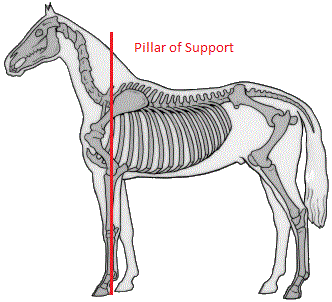
The next thing to look at is the emergence of the neck. Specifically how and where the base of the neck emerges from the chest. Draw a dot there. If the neck emergence is above the point of shoulder, that's an uphill trait. If the neck emergence is at the point of shoulder, that's a level trait. If the neck emergence is below the point of shoulder, that is a downhill trait.
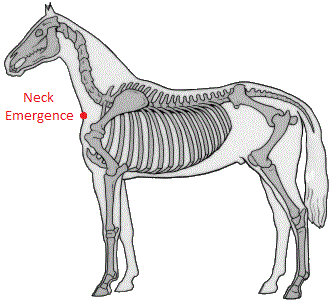
The final thing you need to look for, when assessing functional levelness of build, is the LS (lumbo-sacral gap) placement. The LS gap is the gap between the forward facing vertebrae of the lumbar spine and the rearward facing vertebrae of the sacrum. This can be found by looking for the point of hip and the LS gap itself, set above. Ideally, you want the LS gap and point of croup to be set well forward, and lined up with one another. A forward LS and point of hip is an uphill trait. A middle placed LS gap and point of hip is a level trait. A rear LS gap and point of hip, set back, is a dowhill trait.
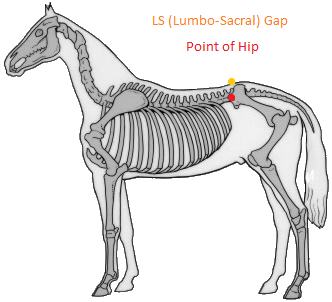
More photos of where the LS gap is located:
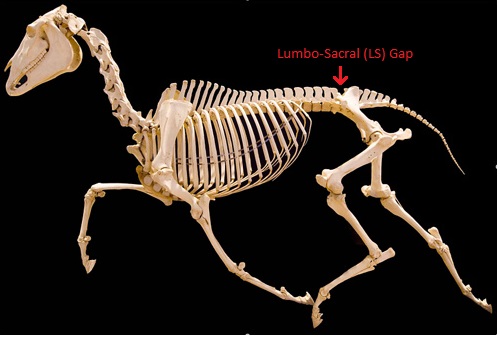
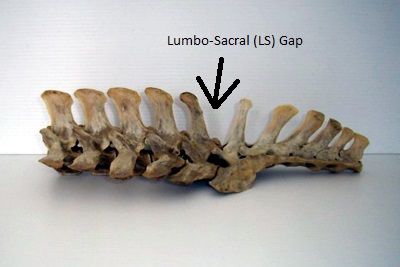
These three things, together, will determine if a horse functionally moves uphill, level, or downhill.
Moving, on, the next thing I like to look for is the shoulder angle. This can be found by using the assessment points a. the point of wither, b. the point of shoulder, and c. the elbow. First find the point of wither. Make a dot there. Then find the point of shoulder. Lastly, find the elbow. Make a dot there. Connect all three with lines so you have a triangle. The lines from the point of wither to the point of shoulder, and the point of shoulder to the elbow will give you the angle of the shoulder, the length of the humerus, and the length of the scapula. The ideal shoulder angle is 90°, if you make a straight horizontal line, a horizon line, through the point of shoulder, this makes it 45°.
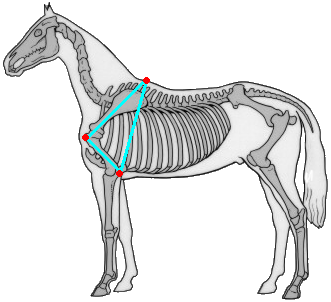
Moving on, the next thing I look at is the hip angle. This can be found by using the assessment points a. the point of hip, b. the point of buttock, and c. the stifle. First find the point of hip. This can be a bit tricky, as it is under the flesh/muscle. It's usually close to directly across from the top of the reverse vertical cowlick on the flank on the hindquarter. Next locate the point of buttock. This can be found usually be following the angle of the croup. Lastly, find the stifle. Connect all three points with lines so you have a triangle, this will give you the angle of the hip and also the length of the femur. Ideally these three lines should be equal in length, an equilateral triangle.
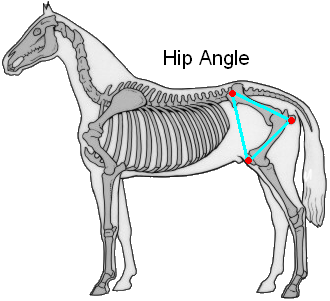
Next I look at the horse's legs to find the cannon length and pastern angles. This is done by using the assessment points a. the knee/hock joints, b. the fetlock joints, and c. the coronary bands. Start by finding the center of the knee joint and the center of the hock joint. Draw dots on them. Then locate the fetlock joints. Draw dots in the middle of them. Then locate the middle of the coronary band angle. Draw dots on them. Connect them with lines. This will show straightness and length of the cannon bones. It will also give you the angle of the pasterns, which should ideally match the shoulder angle on most horses.
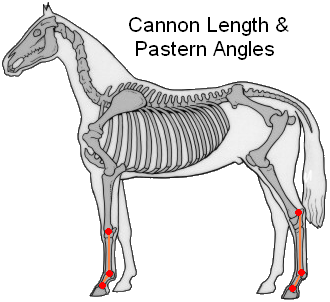
After that I like to check the hock to knee joint ratio. This is useful for spotting things like high-set hocks, low knees, long cannons, etc. To do this all you need to do is find the hock joint. Make a dot there and draw a straight line (a horizon line) across from it. That's all you need to do. Hocks are usually 1/4 higher than the front knee ideally.
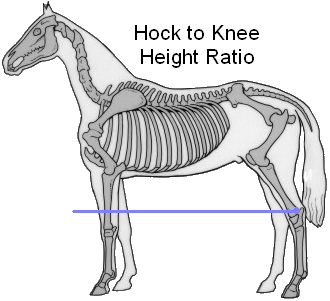
Next I will find the center of balance. This can be done by using the horse's shoulder and hip angles, which you've already found. Draw an unending line in front of the point of shoulder across the point of wither and keep going a ways. Extra is fine. Now draw an unending line behind the point of buttock across the point of hip and keep going a ways. Extra is fine. Where these two lines intersect (meet/cross), straight down to the horse's back, is the center of balance. Ideally this is the space behind the withers, just behind the girth. Basically where the rider would sit.
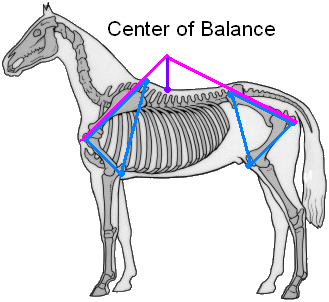
Now you know how to assess the conformation of the horse! Thank you for learning with me! I wish you the best of luck!